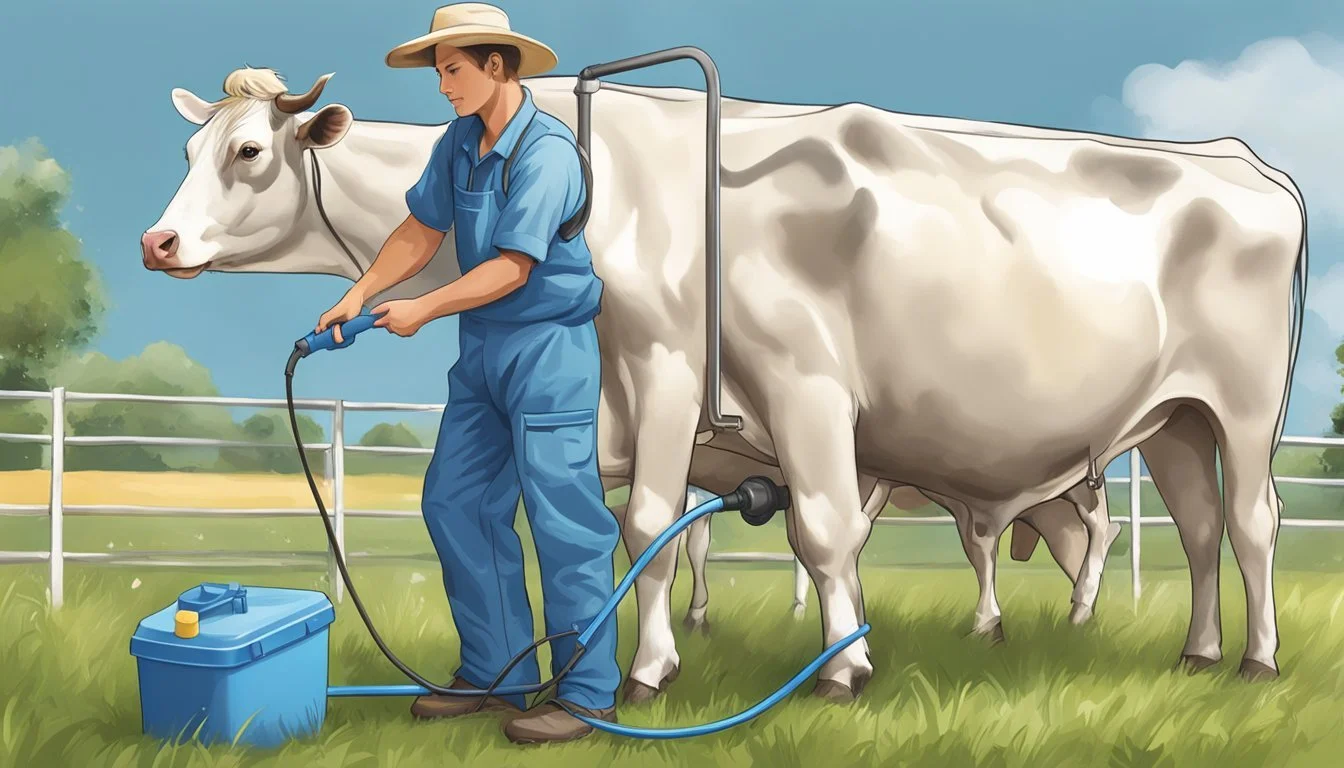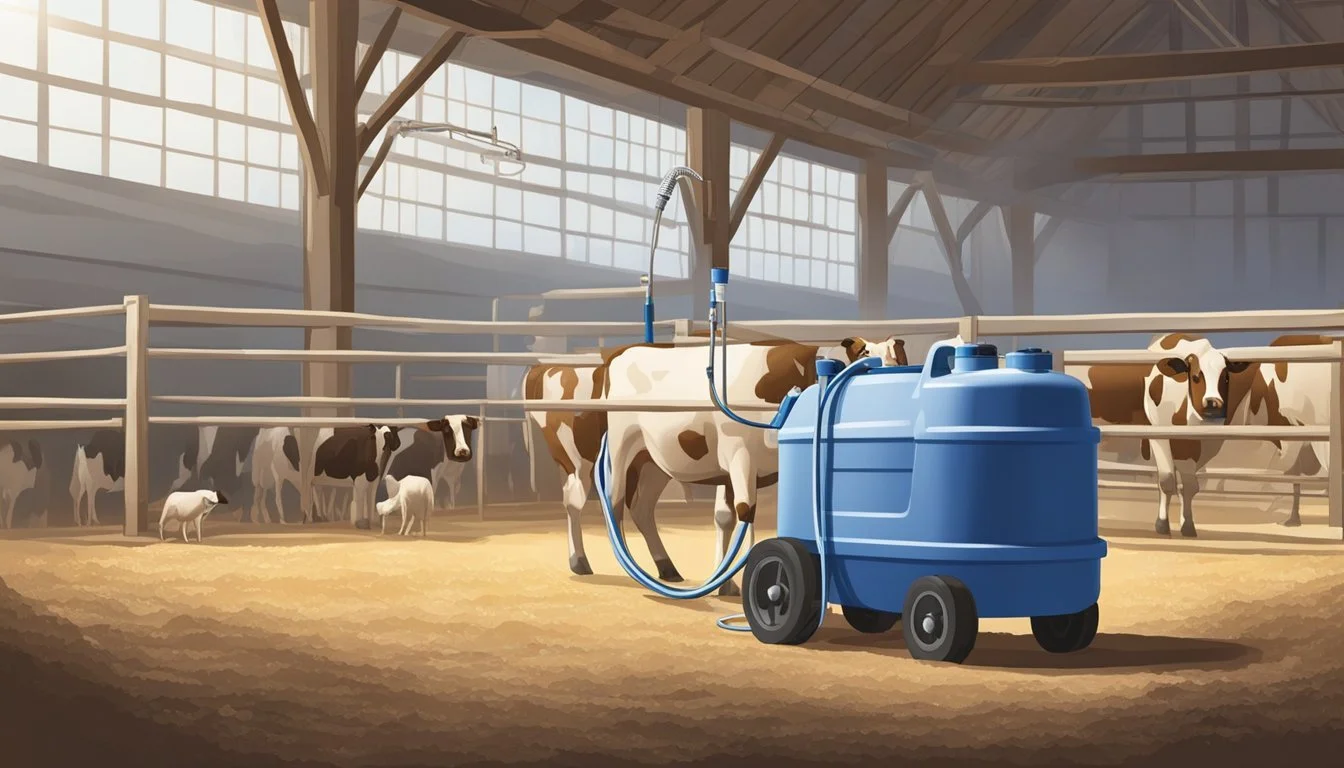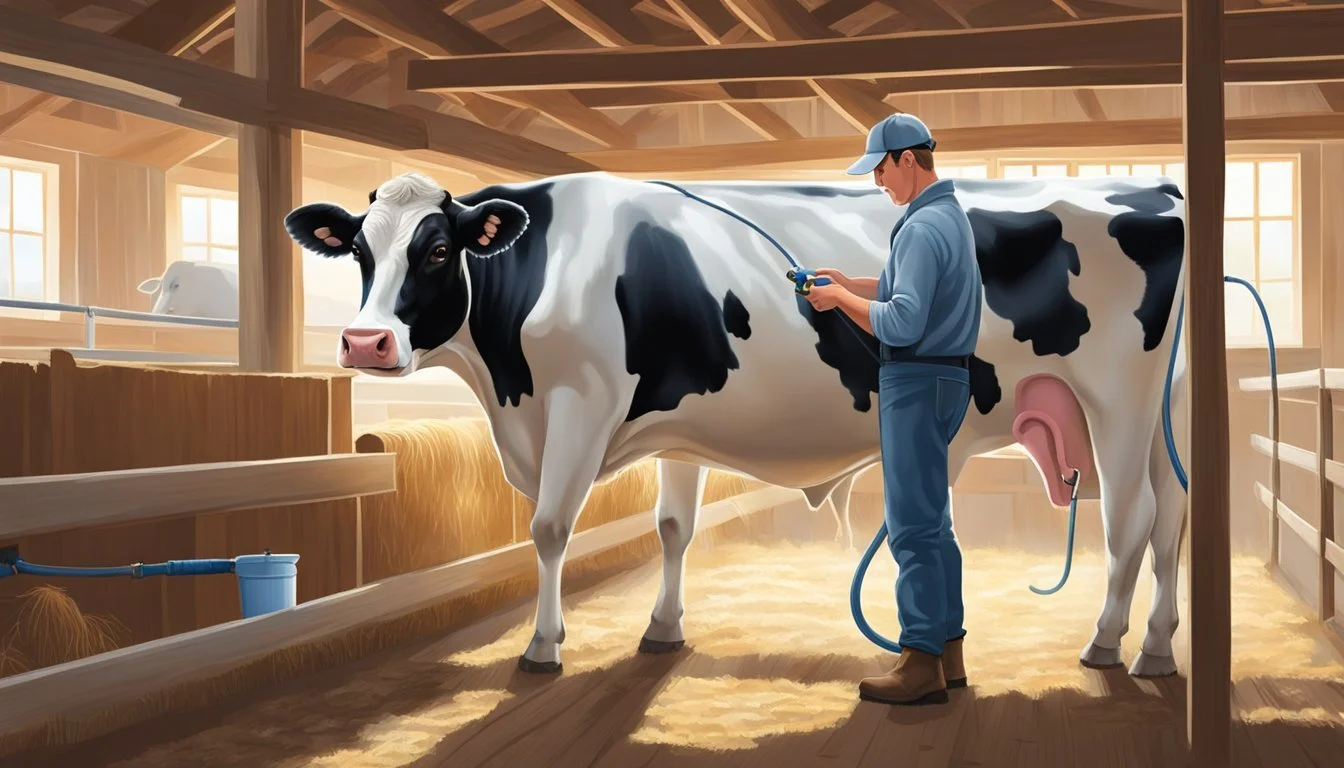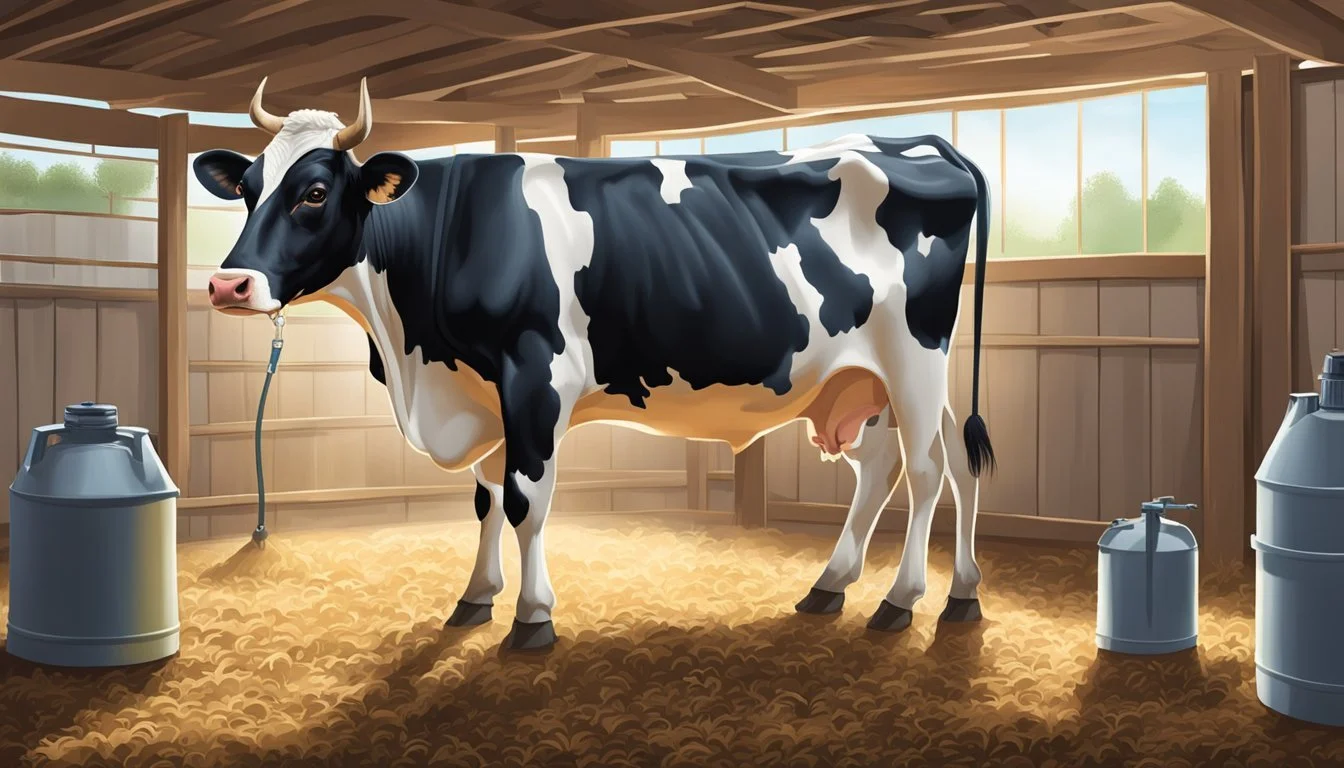The Ultimate Guide to Using a Livestock Teat Sprayer
Mastering Mastitis Prevention and Udder Hygiene in Homesteading
Mastitis remains a significant health concern in dairy cattle, capable of affecting milk production, animal welfare, and farm profitability. One of the foremost tools in combating this common yet concerning condition is the use of a livestock teat sprayer—a device designed to apply antiseptic solutions to the teat and udder after milking. Regular and meticulous application of teat disinfectants is proven to reduce the incidence of mastitis by decreasing the potential for pathogenic bacteria to enter the teat canal.
Homesteaders who raise dairy animals are often looking for effective methods to maintain udder hygiene while balancing other farm responsibilities. The teat sprayer acts as a critical component in their udder health management routine. Proper usage involves a consistent approach to post-milking care, ensuring that the disinfectant covers the entire surface of the teat, forming a barrier against infection. In addition to its role in pathogen prevention, the practice encourages close observation of the animals, allowing for early detection and management of udder health issues.
Prevention strategies do not end with the simple act of spraying; they encompass a broader spectrum of udder management practices. These include maintaining cleanliness of the cow's environment, employing proper milking techniques, and ensuring the teat sprayer itself is routinely checked and maintained to deliver the correct concentration of disinfectant. Integrating these practices into daily routines helps safeguard the health of the herd, maintaining the homestead's sustainability and success.
Understanding Mastitis
Mastitis is a prevalent and complex issue in dairy farming, impacting animal health and milk quality. Effective management is crucial for maintaining udder health and farm profitability.
Definition and Impact on Dairy Farming
Mastitis refers to the inflammation of the mammary gland and udder tissue, primarily caused by bacteria that enter the teat canal. This condition is a significant concern in dairy farming due to its ability to reduce milk production and affect milk quality.
Common Mastitis Pathogens
There are numerous mastitis-causing pathogens, but the most common include:
Contagious pathogens: such as Staphylococcus aureus and Streptococcus agalactiae
Environmental pathogens: like E. coli and Streptococcus uberis
Opportunistic pathogens: which can invade the teat canal under certain conditions
Symptoms and Types of Mastitis
Mastitis presents in two main forms: clinical mastitis and subclinical mastitis.
Clinical mastitis: Visible clinical signs include:
Heat, redness, swelling, and pain in the udder
Abnormalities in the milk such as clots or changes in color
Subclinical mastitis: Detected through increased somatic cell count (SCC) without visible clinical signs
Economic Significance
The economic impact of mastitis on dairy operations is substantial:
Direct costs such as treatment and veterinary services
Indirect costs include loss of milk sales due to discarded milk and decreased production
The bulk tank SCC can serve as an indicator of udder health across the herd, with higher counts typically indicating a mastitis problem.
Effective mastitis management involves regular monitoring and bacterial culture to identify the specific pathogens involved, enabling targeted treatment and control measures to minimize the incidence and spread of the disease.
Mastitis Prevention Strategies
Effective mastitis management hinges on meticulous prevention strategies, ranging from teat sanitation to environmental control measures. Emphasizing teat health and maintaining exemplary udder hygiene are crucial for preventing mastitis, which can severely impact dairy farming productivity.
Teat Disinfection Techniques
Teat disinfection is a cornerstone of mastitis prevention. Post-milking teat dips should contain an effective germicide to eliminate pathogens on the teat skin. Options include:
Iodine-based dips: Generally contains 0.5 to 1% iodine.
Chlorhexidine: Recognized for its residual activity.
It is essential to cover the entire teat with the disinfectant and allow for proper contact time before the teats are exposed to potential contaminants.
Herd Management Best Practices
Strategic herd management plays a vital role in mastitis control. This includes:
Nutrition: Balanced diets contribute to overall udder health. Ensure the feed contains essential minerals like selenium and vitamin E to support the immune system.
Cull problem cows: Chronic carriers of mastitis pathogens should be identified and culled.
Dry cow management: Dry cow therapy and proper nutrition during the dry period can result in healthier cows with fewer instances of mastitis after calving.
Optimizing Milking Hygiene and Technique
Milking hygiene is critical in preventing mastitis. Key considerations:
Milking machines should be regularly serviced to prevent teat end damage.
Milking technique: Ensure complete and gentle milking; over-milking or under-milking can damage teat condition and udder conformation.
Milkers should also wash their hands and wear gloves to reduce the risk of spreading pathogens.
Environmental Control Measures
Effective environmental control reduces mastitis risk by minimizing exposure to infectious agents:
Sanitation: Regular cleaning of the barn and milking parlor to reduce bacterial load.
Bedding: Use clean, dry bedding to reduce udder contamination.
Ventilation: Good ventilation systems lower humidity and decrease bacteria survival rates.
Through these targeted strategies, dairy farmers can maintain optimal udder hygiene and teat care, laying the foundation for a successful and healthy dairy operation.
Livestock Teat Sprayers and Udder Hygiene Products
Effective mastitis prevention in livestock revolves around rigorous udder hygiene, for which teat sprayers and disinfectants are fundamental tools. They ensure the application is both thorough and efficient, decreasing the likelihood of bacterial infection and fostering teat health.
Teat Sprayer Technology and Types
Teat sprayer technology has evolved to offer various solutions for post-milking disinfection. Automatic teat sprayers work by systematically applying disinfectant on the cow’s teats immediately after milking, reducing the risk of mastitis. Users may opt for battery-powered portable units such as the Udder Mister 1.0, designed to withstand demanding farm environments. These devices can be adapted to dispense different teat disinfectants, ranging from iodine-based solutions to chlorine dioxide products.
Selection of Teat Disinfectants
When selecting a disinfectant, it's crucial to identify the major causes of mastitis present. Antimicrobial teat disinfectants should be chosen based on their effectiveness against specific pathogens. Post-milking teat dips should contain an effective antimicrobial agent, but also consider the presence of antimicrobial resistance. Regularly running pathogen checks on milk samples can inform decisions on which agents are best for the farm's needs.
Role of Emollients in Teat Health
Emollients are vital components in teat dips and sprays, offering skin conditioning to prevent chapping and maintain healthy teat condition. Glycerin and lanolin are examples of emollients that help sustain the skin's natural barrier. They aid in the healing process and form a protective layer against environmental irritants, which could otherwise lead to inflammation or infection.
Proper Usage and Application
Proper application is as crucial as choosing the right product. Teat sprayers should ensure complete coverage of the teat's surface, usually achieved by adjusting the nozzle for optimal spray pattern and volume. For the sprayer to fulfill its role in post-milking teat disinfection, it's imperative that the teats are clean before application. Spraying should be performed soon after milking when the teat pores are still dilated to maximize the efficacy of the teat sealant.
Monitoring and Detecting Mastitis
Effective monitoring and detection of mastitis are crucial for maintaining udder health and milk quality in livestock. Precise detection methods enable early intervention, thereby preventing the escalation of the infection and minimizing economic losses.
Somatic Cell Count as an Indicator
Somatic Cell Count (SCC) is a primary tool for detecting mastitis. An elevated SCC indicates an immune response due to mammary gland infection. Dairy farmers rely on Bulk Tank SCC to monitor the overall herd health, while individual cow SCC provides specific infection status. Regular SCC testing helps to:
Identify subclinical mastitis which does not show obvious symptoms.
Assess milk quality as higher SCC usually means lower quality.
California Mastitis Test (CMT) offers a simple on-farm SCC assessment. A color change in the reagent upon mixing with milk provides a quick indication of SCC levels.
Conducting Bacterial Tests
Bacterial tests involve culturing milk samples to identify the pathogens causing mastitis. This method helps to:
Determine the specific bacteria responsible, which is critical for effective treatment.
Prevent milk contamination by ensuring that milk from infected cows is not mixed with the bulk tank.
Regular microbial testing enables strategic decisions on treatment protocols and herd management practices.
Observing Changes in Milk and Animal Behavior
Changes in the milk such as clots or an unusual color can signify an infection. Mastitic milk may also have a decreased production volume. Observation plays a key role in mastitis detection:
Milk Appearance: Clots, discoloration, and a watery consistency can be visual cues.
Animal Behavior: Infected cows may exhibit signs of lethargy, reduced feed intake, or changes in their usual behavior.
Detecting these cues requires vigilant daily inspections by the farmer or a dedicated animal health manager.
Treatment Options and Antibiotic Use
This section explores the structured approach to mastitis in terms of clinical and subclinical infections, the role of antibiotic therapy, and essential practices to mitigate antimicrobial resistance.
Approaches to Treating Clinical Mastitis
Clinical mastitis presents with visible symptoms such as swelling, heat, redness, and abnormal milk (e.g., clots or discoloration). Treatment typically involves antibiotics, with the choice depending on the nature of the infection—whether it's caused by contagious pathogens like Staphylococcus aureus or environmental bacteria. Penicillin is often used to combat Streptococcus agalactiae, a common etiological agent in clinical mastitis.
Intramammary antibiotics are directly infused into the teat to clear the infection.
Systemic treatments might be necessary for severe cases presenting with fever and systemic inflammation.
Managing Subclinical Infections
Subclinical mastitis lacks visible symptoms but can be detected by a high Somatic Cell Count (SCC) in milk. Management strategies focus on:
Conducting regular Milk SCC testing to identify potential issues early on.
Using specific antibiotics when necessary, aimed at the mastitis pathogens identified in milk samples.
Early detection and targeted treatment help prevent the progression to clinical mastitis and maintain herd health.
Understanding Antibiotic Therapy
Antibiotic therapy for mastitis should be guided by:
Pathogen Identification: Knowing the specific bacteria causing the infection, whether it's a case of contagious mastitis by Mycoplasma or an environmental bacterial infection.
Sensitivity Testing: Determines the most effective antibiotic for the identified pathogen.
Targeted antibiotic therapy ensures the treatment is effective against the causative agents without overuse of broad-spectrum antibiotics.
Preventing Antimicrobial Resistance
To prevent antimicrobial resistance, it’s crucial to adopt prudent antibiotic use:
Apply intramammary treatments only when justified by clinical signs or test results.
Practicing good udder hygiene can prevent infections, reducing the need for antibiotics.
The careful approach to antibiotic use is key in retaining their effectiveness against mastitis pathogens.
Animal Health and Nutrition
In managing livestock health, particularly in homesteading, the link between nutrition and the prevention of diseases like mastitis is crucial. Ensuring animals receive optimal nutrition fortifies their immune system, directly impacting their capacity to stave off infections.
Role of Nutrition in Mastitis Prevention
A balanced diet for livestock is fundamental for maintaining overall health and especially critical in preventing mastitis, an inflammation of mammary tissue that can severely affect milk production and quality. Adequate nutrition bolsters an animal's immune response, reducing the incidence of infection. Specific nutrients, such as selenium and vitamin E, play protective roles in immune function and anti-inflammatory processes.
Nutrients important in mastitis prevention:
Selenium: An antioxidant that supports immune health.
Vitamin E: Helps reduce the severity of mastitis infections.
The inclusion of these nutrients in a livestock diet can preempt the occurrence of mastitis while also contributing to the healing process should an infection arise.
Vitamins and Supplements for Immune Support
Vitamins and supplements are integral components of a livestock nutrition program aimed at ensuring robust health and disease resistance. Vitamin E, in particular, is recognized for its role in enhancing the animal's immune system, thus contributing to mastitis prevention.
Recommended Vitamins and Supplements:
Vitamin E: Minimum of 1000 IU/day to support immune function.
Balanced Minerals: Including calcium, phosphorus, and others for overall health.
The incorporation of these vitamins and supplements into daily feeding regimens can lead to noticeable improvements in an animal's resilience to diseases such as mastitis, leading to a healthier, more productive, farmstead.
Management at Dry-Off
The transition to the non-lactating period is critical for udder health and controlling mastitis. Proper management at this stage not only aids in the injury repair process from machine milking but also prepares the udder for the next lactation cycle. Ensuring the use of appropriate dry cow therapy and implementing effective strategies to reduce mastitis can make a significant difference in overall herd health.
Dry Cow Therapy and Udder Health
Dry cow therapy is an important practice to ensure udder health during the dry period. This includes the use of specific intramammary infusions, typically antibiotics, which are administered at the last milking before dry-off to target existing infections and prevent new ones. Here are key steps in the process:
Administer Dry Cow Therapy: Immediately after the final milking, infuse each teat with an approved dry cow antibiotic.
Post-Milking Teat Dipping: After infusion, dip teats in an antiseptic solution to guard against bacteria that could cause new infections.
This comprehensive approach assists in supporting the cow's natural defenses during the dry period when the risk of udder problems can increase.
Strategies for Reducing Mastitis During Dry Period
The dry period presents an increased risk for the development of mastitis, and strategies to mitigate this risk are essential. They include:
Sanitation: Maintain rigorous cleanliness during and after the dry-off procedure to prevent bacterial contamination.
Environmental Management: Provide a clean and comfortable environment to minimize exposure to mastitis-causing pathogens.
Proper Nutrition: Adequate nutrition supports immune function and udder health throughout the dry period.
Monitor Udder Health: Regularly check for signs of mastitis and take prompt action if any udder problem is detected.
By employing these tactics, one can minimize the risk of infection, ensuring that the cow's udder health is well-maintained throughout the non-lactating period until the commencement of the next lactation phase.
Special Considerations for Homesteading
When transitioning commercial dairy practices to a homestead scale, two aspects demand attention: the scalability of teat sprayers for mastitis prevention and the implementation of DIY solutions for udder hygiene in dairy herds.
Adapting Commercial Practices to Homestead Scale
The dairy industry often uses sophisticated equipment for udder management and mastitis prevention. On a homestead, the focus should be on scaling down such practices. A teat sprayer is an essential tool during the lactation period for maintaining udder health. Homesteaders should choose teat sprayers that suit their herd size while adhering to public health standards for raw milk production.
Key attributes for homestead teat sprayers:
Durability: Must withstand frequent use and varying conditions.
Simplicity: Easy to use and maintain by individuals without specialized training.
Efficiency: Should adequately cover the teat with disinfectant while conserving the solution.
DIY Teat Spraying Solutions
Homesteaders may opt for DIY teat spraying solutions to manage costs and maintain udder hygiene. The DIY approach requires knowledge of proper dilution rates and solution composition to prevent udder problems such as neb and ensure effective mastitis prevention.
DIY solution must-have components:
Disinfectant: Typically, iodine or chlorhexidine-based products are effective.
Emollient: Helps to moisturize and condition the skin, often includes glycerin or aloe.
Carrier: Distilled water is a preferable carrier to ensure solution purity.
The proper use of teat sprayers can significantly contribute to udder health, which is crucial for providing safe and quality milk for homestead consumption and sale. Each homesteader must tailor their practices to their specific scenario, always prioritizing the well-being of their dairy herds.
Mastitis and Public Health
Mastitis, a prevalent bacterial infection in dairy cattle, has direct implications for public health due to its impact on milk quality, particularly when considering the consumption of raw milk. Effective mastitis prevention and udder hygiene not only benefit the dairy industry but also safeguard consumers from potential health risks.
Risk of Pathogens in Raw Milk
Raw milk from cows with mastitis often contains microorganisms that can pose a threat to human health. The American Dairy Science Association has reported that common mastitis-causing pathogens include Streptococcus, Staphylococcus aureus, and coliforms. These bacteria can lead to:
Subclinical infections, which may not be easily detectable in dairy herds but can result in bacterial contamination of milk.
Clinical mastitis, which presents more obvious symptoms in cows, can lead to more severe milk contamination.
Public Health Initiatives and Education
Public health initiatives aim to minimize the risk of mastitis-related pathogens entering the human food chain.
Key strategies include:
Education programs about the importance of hygiene and proper handling of milk to prevent the spread of mastitis-related microorganisms.
Encouraging pasteurization to eliminate bacterial infection from environmental sources and infected animals.
These programs, driven by health organizations and associations such as the American Dairy Science Association, work towards maintaining milk safety standards, ensuring milk quality, and protecting consumer health.
Innovative Approaches to Mastitis Control
Mastitis control in dairy cattle has seen significant innovation, with new research and technologies emerging to improve udder health. These advancements encompass an array of strategies, from comprehensive mastitis control programs to the application of cutting-edge technologies.
Advancements in Mastitis Research
Research has played a critical role in understanding the pathogens involved in mastitis, including bacteria like Trueperella pyogenes and yeasts. Studies indicate that effective mastitis control requires a multifaceted approach involving both cow-level and quarter-level considerations. Here are some key research insights:
Disease Etiology: Improved understanding of udder tissue infections and the specific pathogens responsible for mastitis.
Disease Management: Research into the herd management factors and how they relate to sealant performance for mastitis prevention.
Emerging Technologies in Udder Health
The application of technology in mastitis prevention and udder hygiene has led to innovative solutions:
Diagnostic Tools: Development of more accurate diagnostic tools for early detection of mastitis.
Data Analytics: Use of big data and analytics to predict and manage mastitis risk.
Udder Sanitation Devices: Introduction of advanced livestock teat sprayers designed for superior udder cleanliness and mastitis prevention.
Collectively, these innovations are shaping the future of mastitis control and promoting healthier dairy herds.






